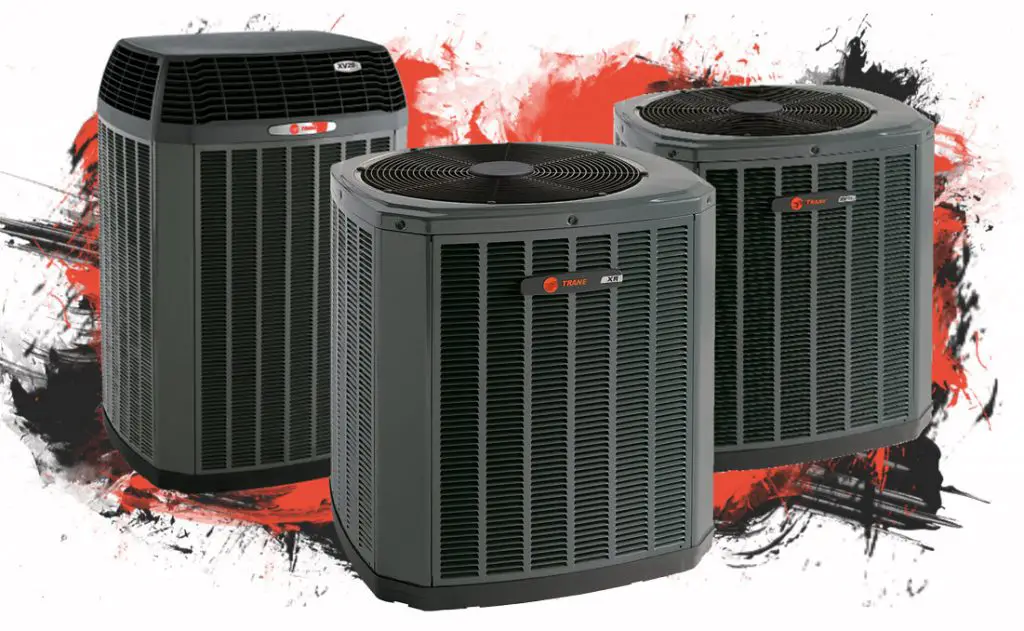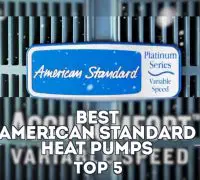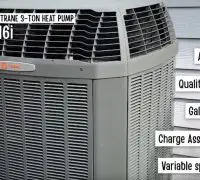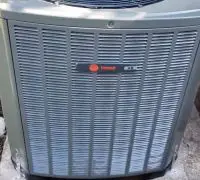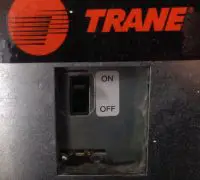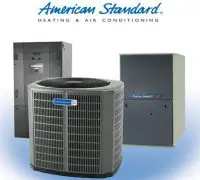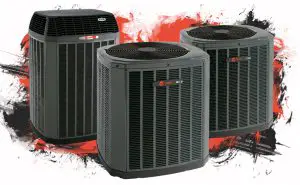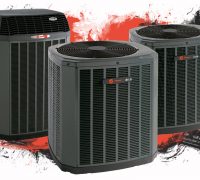When you look at the heat pumps out there, you can easily see that many customers have the best of words about Trane heat pumps. Their energy efficiency is one of the main attributes of the Trane heat pumps. Most recent Trane heat pumps have a SEER rating between 18 and 20 and all models have some of the highest SEER ratings. Even if you find heat pumps with a slightly higher SEER rating, none of them will be as quiet as Trane models.
Page Table of Contents
Trane heat pumps are excellent. But why?
Trane has always been one of the most representative heating and cooling solutions manufacturers. The “It’s hard to stop a Trane” logo has been used for more than two decades and it perfectly describes what to expect when you buy a Trane product. Here’s how Trane heat pumps stand out on the market:
Energy efficiency
The Trane heat pumps run on electricity and manage to be some of the most effective HVAC systems. Heat pumps with high HSPF (Heating Seasonal Performance Factor) ratings give the most heat while utilizing the least energy. Shortly put, the higher the HSPF, the lower the spending.
Quality control testing
The SEET (Systems Extreme Environmental Test) lab in Tyler, Texas, regularly tests Trane products. The Trane products go through a 16-week toucher test. They are exposed to extreme cold and hot temperatures repeatedly in two-week sessions. Sometimes, units have to run for 2,600 hours as part of the testing. Afterward, they are tested for corrosion resistance and sprayed with salt for seven days. Since only products that successfully pass the tests make the production and selling, it’s understandable why Trane products are top-rated within their category.
Durability
Trane technicians pay attention to the most minute detail when making Trane heat pumps. They focus on creating the most durable and dependable products. Other manufacturers use the basic materials common for the market to make their products. It’s not the case with Trane, where designs, builds, and tests are constantly run for each part in-house. Trane teams get the best out of each material and push the industry standards so that they achieve the high standards. For instance, Trane uses only the long-lasting Climatuff compressor for residential systems. The systems are quiet, highly efficient, and durable. The Spinefin coil and the all-aluminum outdoor ensure exceptional heat-exchanging abilities and better resistance than standard copper/aluminum coil resistance.
Warranty
If you buy a Trane residential system, you will benefit from a Base Limited Warranty. The warranty is for components that break because of a manufacturer defect and not any labor spending. The Base Limited Warranty varies from 1 to 20 years, depending on the product.
Should you register your Trane product within 60 days after the installation, the warranty turns into a Registered Limited Warranty—without any additional fees. The registered warranty ranges from 5 to even lifetime, depending on your products. You can register your product online or by phone. There’s also available the Optional Extended Warranty that covers the spending of parts and labor. You need to pay extra to get this type of warranty, so contact your local Trane dealer.
What’s the life expectancy for Trane heat pumps?
Trane heat pumps present the longest life expectancy in the industry; your Trane heat pump will last up to 19 years and no less than 15 years. However, the durability of a heat pump depends on many factors. Please keep reading to get the most out of your Trane heat pump:
Installation
Adequate installation is crucial for the durability of heat pumps, Trane or not Trane. Proper refrigerant line sizing, proper refrigerant levels, correct duct sizing, and selecting the appropriate size for the unit in your home will profoundly impact the life expectancy of the Trane heat pump.
Maintenance
Routine maintenance plays a vital role in the durability of heat pump systems. Some parts of the heat pumps (the capacitor and contactor) last for 7 to 9 years. If not properly maintained, the two components will damage the compressor and make the unit fail long before its time. Stay on top of routine maintenance to enjoy your Trane heat pumps for the longest time.
What are the unique features of Trane heat pumps?
The energy-efficient Trane heat pumps stand out with the silent operation. As a matter of fact, they make for the quietest heat pumps. The variable-speed compressor is crucial to obtain the silent operation. Here’s something amazing: Trane heat pumps have the lowest noise levels within the heat pump category—54db. It’s as “loud” as the sound of your refrigerator.
The list of impressive features doesn’t stop here and also includes:
- Unique louvered panels that ensure excellent protection for the coils
- Advanced diagnostics on the control board for easy troubleshooting
- Two-stage cooling and three-stage heating (for some models)
- Sound insulation on high-end units
What to expect from your Trane heat pump?
You will definitely appreciate the TruComfort feature, a patent that precisely controls the temperature by 1 or 2 degrees and eliminates temperature fluctuation.
Another optional function for the high-end models is the Trane Communicating System. You will pay a monthly fee, but some customers opt for it.
Trane XR series
Here is the lower price area, which includes solid efficiency and affordable pricing. You can find single-stage units with a 17SEER rating and 9.7 HSPF.
Trane XL series
The series consists of units with inverter compressor technology, Comfortlink II communicating technology, and a variable-speed blower. The efficiency varies between 17 to 18 SEER, respectively 9.5-9.6HSPF. The XL18i has highly appreciated thanks to its two-stage Climatuff compressor.
Trane XV series
The units in the XV series have the same features as models in the XL series, but also a variable speed blower and a variable speed compressor to identify the changes in the outdoor temperatures accurately. The units self-adjust in increments of 1/10th of 1%, so the indoor temperature remains within a one-half degree of the thermostat setting. Units in this category have whooping 21 SEER efficiency and 10 HSPF.
